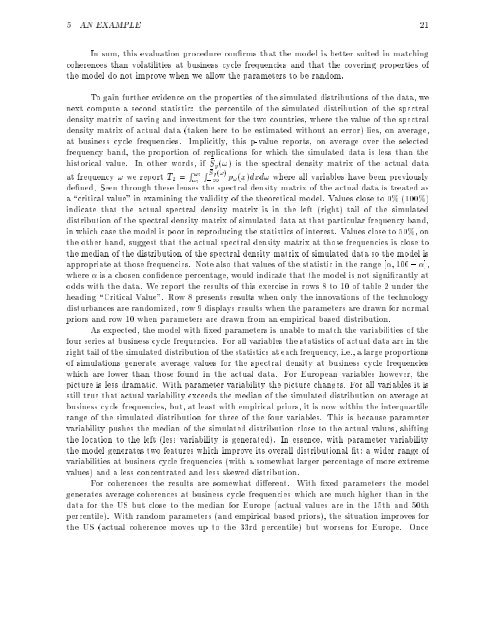Testing Calibrated General Equilibrium Models - Universitat ...
Testing Calibrated General Equilibrium Models - Universitat ...
Testing Calibrated General Equilibrium Models - Universitat ...
Create successful ePaper yourself
Turn your PDF publications into a flip-book with our unique Google optimized e-Paper software.
5 AN EXAMPLE 21<br />
In sum, this evaluation procedure con rms that the model is better suited in matching<br />
coherences than volatilities at business cycle frequencies and that the covering properties of<br />
the model do not improve when we allow the parameters to be random.<br />
To gain further evidence on the properties of the simulated distributions of the data, we<br />
next compute a second statistic: the percentile of the simulated distribution of the spectral<br />
density matrix of saving and investment for the two countries, where the value of the spectral<br />
density matrix of actual data (taken here to be estimated without an error) lies, on average,<br />
at business cycle frequencies. Implicitly, this p-value reports, on average over the selected<br />
frequency band, the proportion of replications for which the simulated data is less than the<br />
historical value. In other words, if Sy(!) is the spectral density matrix of the actual data<br />
at frequency ! we report T 2 = R !2<br />
!1<br />
R Sy (!)<br />
;1 p!(x)dxd! where all variables have been previously<br />
de ned. Seen through these lenses the spectral density matrix of the actual data is treated as<br />
a \critical value" in examining the validity of the theoretical model. Values close to 0% (100%)<br />
indicate that the actual spectral density matrix is in the left (right) tail of the simulated<br />
distribution of the spectral density matrix of simulated data at that particular frequency band,<br />
in which case the model is poor in reproducing the statistics of interest. Values close to 50%, on<br />
the other hand, suggest that the actual spectral density matrix at those frequencies is close to<br />
the median of the distribution of the spectral density matrixofsimulated data so the model is<br />
appropriate at those frequencies. Note also that values of the statistic in the range [ 100 ; ],<br />
where is a chosen con dence percentage, would indicate that the model is not signi cantly at<br />
odds with the data. We report the results of this exercise in rows 8 to 10 of table 2 under the<br />
heading \Critical Value". Row 8presents results when only the innovations of the technology<br />
disturbances are randomized, row 9 displays results when the parameters are drawn for normal<br />
priors and row 10 when parameters are drawn from an empirical based distribution.<br />
As expected, the model with xed parameters is unable to match the variabilities of the<br />
four series at business cycle frequencies. For all variables the statistics of actual data are in the<br />
right tail of the simulated distribution of the statistics at each frequency, i.e., a large proportions<br />
of simulations generate average values for the spectral density at business cycle frequencies<br />
which arelower than those found in the actual data. For European variables however, the<br />
picture is less dramatic. With parameter variability the picture changes. For all variables it is<br />
still true that actual variability exceeds the median of the simulated distribution on average at<br />
business cycle frequencies, but, at least with empirical priors, it is now within the interquartile<br />
range of the simulated distribution for three of the four variables. This is because parameter<br />
variability pushes the median of the simulated distribution close to the actual values, shifting<br />
the location to the left (less variability is generated). In essence, with parameter variability<br />
the model generates two features which improve itsoverall distributional t: a wider range of<br />
variabilities at business cycle frequencies (with a somewhat larger percentage of more extreme<br />
values) and a less concentrated and less skewed distribution.<br />
For coherences the results are somewhat di erent. With xed parameters the model<br />
generates average coherences at business cycle frequencies which aremuch higher than in the<br />
data for the US but close to the median for Europe (actual values are in the 15th and 50th<br />
percentile). With random parameters (and empirical based priors), the situation improves for<br />
the US (actual coherence moves up to the 33rd percentile) but worsens for Europe. Once
















